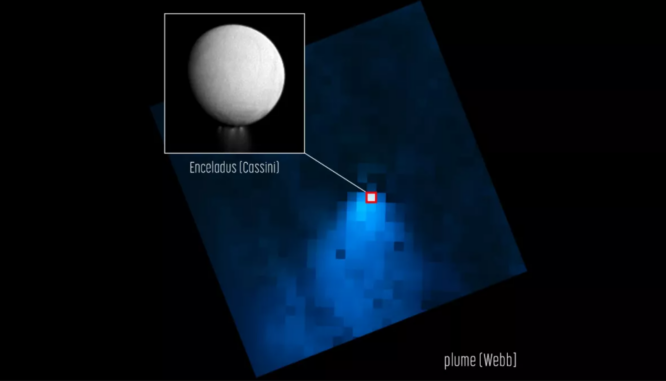The James Webb Space Telescope discovered a 9,000-mile-long plume of water erupting from Saturn’s small, ice-covered moon Enceladus, forming an enormous cloud of water in the planet’s orbit.
Enceladus is one of the most likely locations in the solar system to sustain extraterrestrial life. The new observation by the James Webb Space Telescope (JWST) suggests that the large telescope may play a role in assisting scientists in deciding whether to search for it and how best to do so.
In 2005, the Cassini mission headed by NASA discovered water plumes on Enceladus during a series of near flybys. However, at that time, scientists had only a limited comprehension of the actual strength of these geysers.
Now, JWST has enabled scientists to analyze the chemical composition of these watery streams. “With the James Webb telescope, we can measure water from afar and see the entire view for the first time,” said Geronimo Villanueva, primary author of the study and researcher at NASA’s Goddard Space Flight Center.

The plume is 20 times wider than the small ice-covered moon at 6,000 kilometers.
Although scientists expected to detect water on Enceladus, Webb’s initial observation of the moon yielded a result that utterly surprised them.
Despite its diminutive size, Enceladus has a significant impact on the environment surrounding the gas giant, which it orbits in less than two days. The geyser of water generates a massive cloud of water in the moon’s aftermath, which resides in Saturn’s orbit and extends to the planet’s other moons.
The analysis of data revealed that only 30 percent of the water that makes up the donut-shaped water vapor is still present. The remainder, approximately 70%, is distributed throughout the rest of Saturn’s system and beyond, according to NASA.
Scientists are intrigued as to what else this potent spray may be dispersing throughout the solar system. Methane, carbon, oxygen, and phosphorus were identified as possible biomarkers in the Enceladus plume by a previous analysis of Cassini data.
As its liquid ocean is situated between a thick icy shell and a rocky interior that provides a source of nutrients, scientists believe the little moon has all the necessary conditions for the emergence of primitive forms of life.
Due to the moon’s close proximity to Saturn, its interior is subject to immense gravitational forces, which generate heat and, possibly, chemical reactions that could facilitate the emergence of microorganisms.
However, Villanueva stated that Webb did not discover any traces of these molecules during its initial examination of the intriguing aquatic world.
“We did not detect them in these measurements, but we hope to detect them in the future if they are there,” Villanueva explained.

